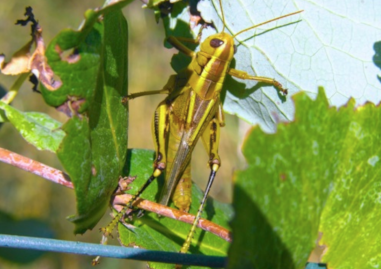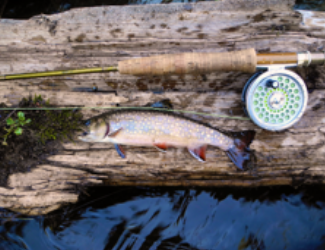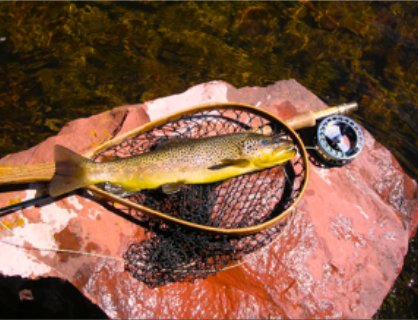
This article appeared in the 2014 book “Modern Terrestrial” by Rick Takahashi and Jerry Hubka. This is original version that I wrote. I also formatted this for the website. These are also my photos and were not included in the book.
Introduction
Modern terrestrial fishing was effectively born when Vince Marinaro lay down along the banks of the Letort during the 1940’s and began to observe the minute insects, including small terrestrial insects, which were a major food source for those selective trout. Marinaro, along with a cohort of anglers including the likes of Ed Koch, Charlie Fox and Ernst Schwiebert, began to develop the flies and promote the notion of fishing with something other that the standard dry flies of the day. Now summer terrestrial fishing is one of the highlights of the trout season, yet few fishermen seem to take advantage of the opportunities that come with the warm summer days. On breezy afternoons, when aquatic hatches are sparse, trout will move into the shallows, along the edges of the river, in anticipation of terrestrial insects arriving on the water. The key to taking advantage of these opportunities is to move slowly, spending more time observing than casting. Sometimes trout can be very close to the bank and these fish are easily spooked back into the deeper water at the center of the river so anglers must wade slowly and cautiously.

I use the lightest weight rods I can given the wind conditions. Typically two and three weights are standard, however, I will use a five weight on windier days. Occasionally, I will use up to a seven weight on really windy days, which I have encountered on summer afternoons in Montana. I use seven and a half foot to nine-foot leaders that have a 4X tip. With that leader I can use tippets that range from 4X to 6X allowing me to fish large hoppers to small ant and beetle patterns.
Prospecting Along the Edges
As trout move to the edges of the river, anglers should use a quiet approach. Wading carefully, spend more time looking for trout than casting. If a fish is very shallow, they will normally take an ant or beetle. If you are not seeing any trout along the edges, then use a larger search pattern such as cricket or hopper pattern. Fishing a fairly wooded river, such as the Au Sable in Michigan or the Frying Pan in Colorado, use a cricket pattern. If the river has more open banks with grassy open fields next to it, such as the lower Roaring Fork River in Colorado or the Madison River below Quake Lake in Montana, then use a hopper fly. In western rivers work up stream wading near the bank. Make your first cast very close to the edge of the river, with successive casts, work out to the deeper water. If a fish shows to the larger fly, but doesn’t eat, then stop, switch to a smaller ant or beetle, and cast to the same spot. Most times the fish will take the smaller pattern without hesitation. Look for current edges, the most productive of which is where a riffle enters a run. Normally there is a V shaped section of water right next to the bank just as the run starts. Begin back from that section and work you way into the quiet water along the bank. This is a perfect place for trout, because they have the deeper water of the run to escape into, and the shallow water with less current along the bank to move into to feed. Even if you do not see fish rising or holding in these areas they are normally there and waiting for an opportunity to feed. I often fish the Au Sable in Michigan during the summer. I will work quietly, moving downstream, casting to the shadows back in the cedar sweepers. Even during the middle of the day, the fish hiding in these shadowed places will respond to a well cast ant or beetle. While catching mostly smaller brook trout, you will occasionally encounter the larger brown trout that can be a challenge to work out of the wooded cover and out into the river. While the main focus is on edges of the river make the occasional cast to the runs and riffles in the center of the river.

Sometimes fish will respond, especially if you are fishing a larger fly. Don’t overlook the unlikely places. I’ve waded up into very shallow riffles on the Frying Pan where few anglers will fish. Searching along the edges, there will be the deeper cuts along the bank. Sometimes the pocket needs to only be slightly deeper that the surrounding water to hold fish. Look for places in areas that don’t get fished by other anglers. One summer in Yellowstone Park I was fishing the Buffalo Ford section of the Yellowstone River. Most of the anglers were out past the gravel flat, nymphing the deeper run. As I was went wading through the gravel flat I discovered that wherever there was a small depression in the gravel there would usually be a one or more Yellowstone Cutthroats. If unaware of my presence, they would readily rise to an ant pattern.
Anting the Hatch
In 1982, the late Ken Miyata wrote an article titled “Anting the Hatch”. You really don’t need to read the article to understand the concept, since the title says it all. Anting the hatch has been a consistently successful strategy for me over the last three decades. For whatever reasons trout love ants and will normally take them with no hesitation. During hatches of aquatic insects I will always begin by trying to match the hatching insect first, however if I get no interest or short rises I will quickly try an ant pattern. Trout seem almost always willing to eat an ant even during heavy hatches. Following hatches, search for eddies along the sides of the river. The Green River in Utah has some huge eddies that collect any insects that have been on the water. Trout will often be seen in these eddies taking advantage of this smorgasbord of insects floating amid the debris and foam. While trout will rise to an aquatic pattern of the hatch of the day, they seem to especially relish an ant or beetle pattern. I’ve seen trout move a considerable distance to take an ant when they discover it floating amid the many other insects. Don’t overlook small eddies either. Small eddies will often have one or two trout in them and all the same principles apply that are true of larger eddies.
Shadows and Sun
Finally, be predatory in your fishing. Spend less time casting and more time observing. Pay particular attention to places on the river where shadows exist along the bank of the river. Trout are nearly impossible to see in these areas, but if you resist casting and observe, they will often reveal themselves with a sipping rise or a tail or caudal fin appearing on the surface. Once you’ve located a fish, then make a cast. If the fish is unaware of your presences, then they will almost always rise to your offering. Shadows are also good places for an angler to stand to observe the river. It is much harder for trout to be aware of your presence if you are not in the sun. I also find it easer to see the river and trout from a shadowed place. When looking for fish in sunlit run, it’s not unusual to first see the shadow the fish casts on the bottom of the river rather than the fish itself. Once I have observed and discovered trout, then I can begin to plan my approach so as not to spook the fish.
Conclusion
While I will not dispute the effectiveness of other methods, hunting trout with terrestrial fly patterns is a key strategy for me in the summer. If there are no aquatic hatches on the river, I will always try terrestrial fly patterns. Rarely do I need to consider other methods, as I will almost always catch trout using these flies.